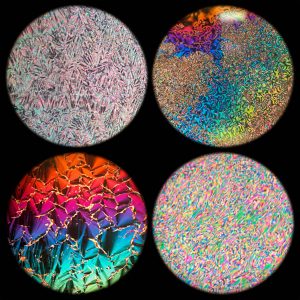Happy Accidents in Liquid Crystals
Liquid crystals (LC’s) are special phases of matter. They possess some properties of a liquid: some of their units can move freely. At the same time, these complex fluids have crystalline properties: these materials could have anisotropic interactions with external stimuli or could have spatial periodicity.
Because of the distinctive arrangement of their constituent molecules, LC’s are birefringent, which means the refractive indices along different axes of the material are unique. As such, when visualized under Polarized Optical Microscopy (POM) LC’s reorient light, and often produce colorful images.
These samples were “happy accidents” that occurred while researching LC’s. Specifically, the top left, bottom left, and bottom right images are of a lyotropic chromonic LC called DSCG. This liquid crystal is made up of plank-like molecules in an aqueous solution that stack into linear columns to form nematic phases. When a sample dries out, the background water solution evaporates, leaving fascinating and unusual crystalline textures appearing under POM.
The top right image shows monolayer-thick nanoparticle films on a common LC, 5CB, in the smectic phase. Here changes in the sample thickness correspond to retardation of light. This is made apparent by colorful fringes under POM. At the same time, particles which sit atop the liquid crystal cause the molecules to tilt and squeeze, causing reorientation of the molecular director underneath the films.
These images were created by Yvonne Zagzag and Sophie Ettinger, and obtained while researching the following
DOI: 10.1039/d1sm01209f
Beautiful Science page

